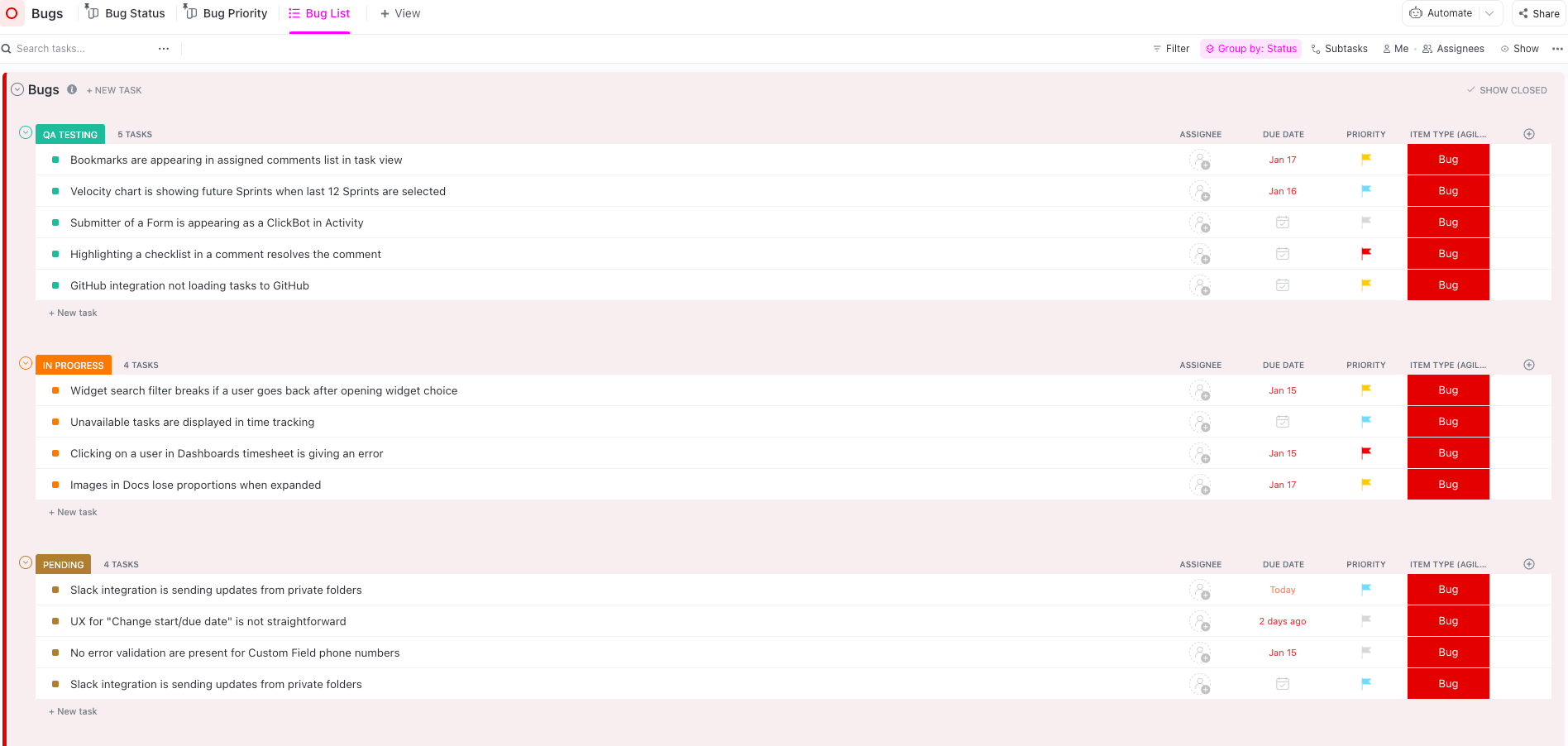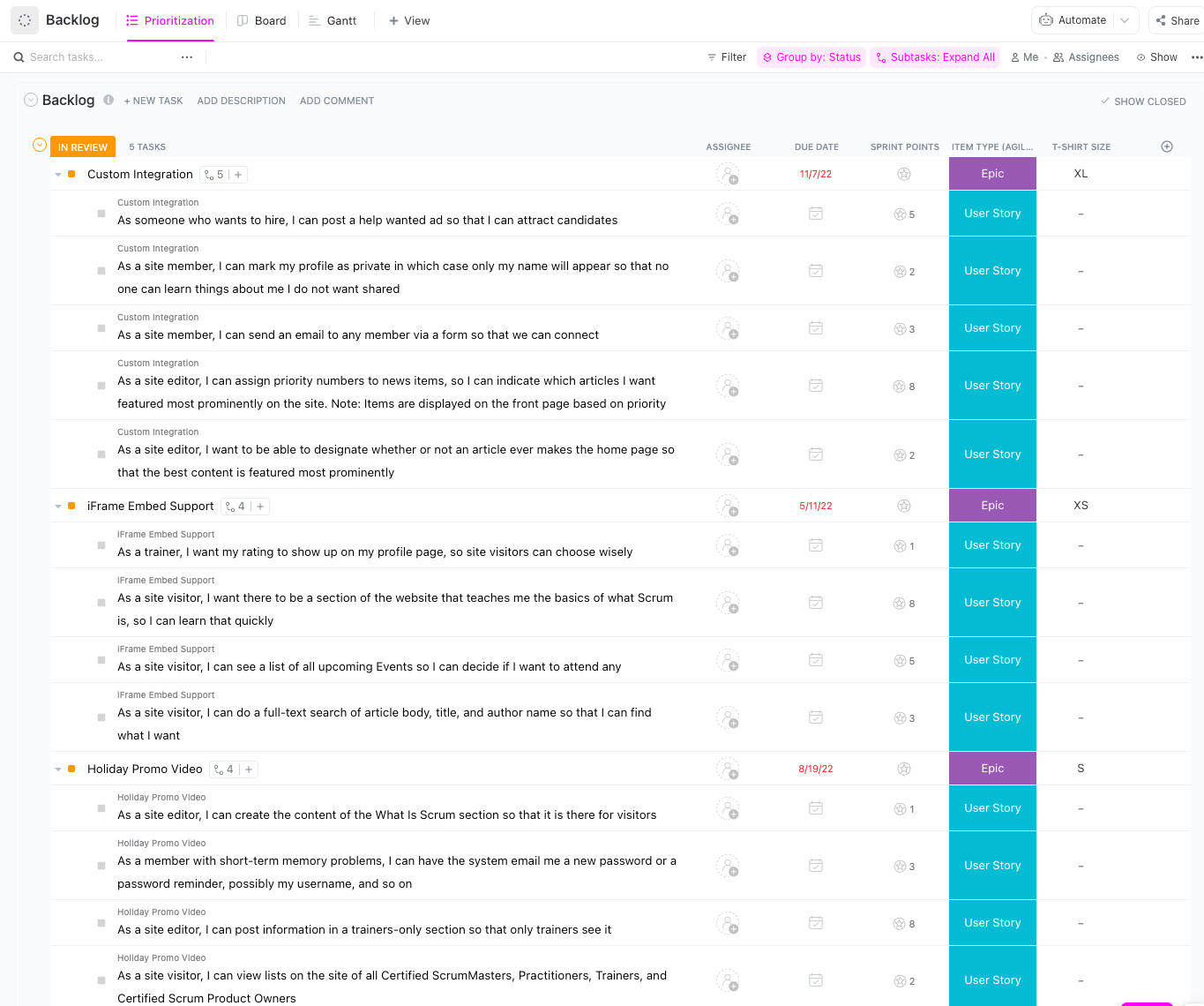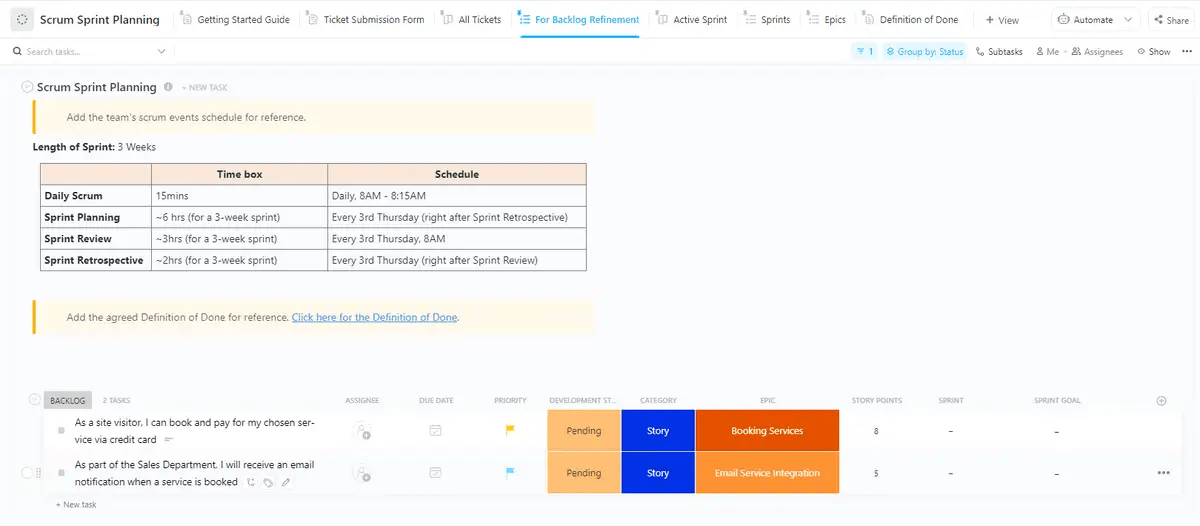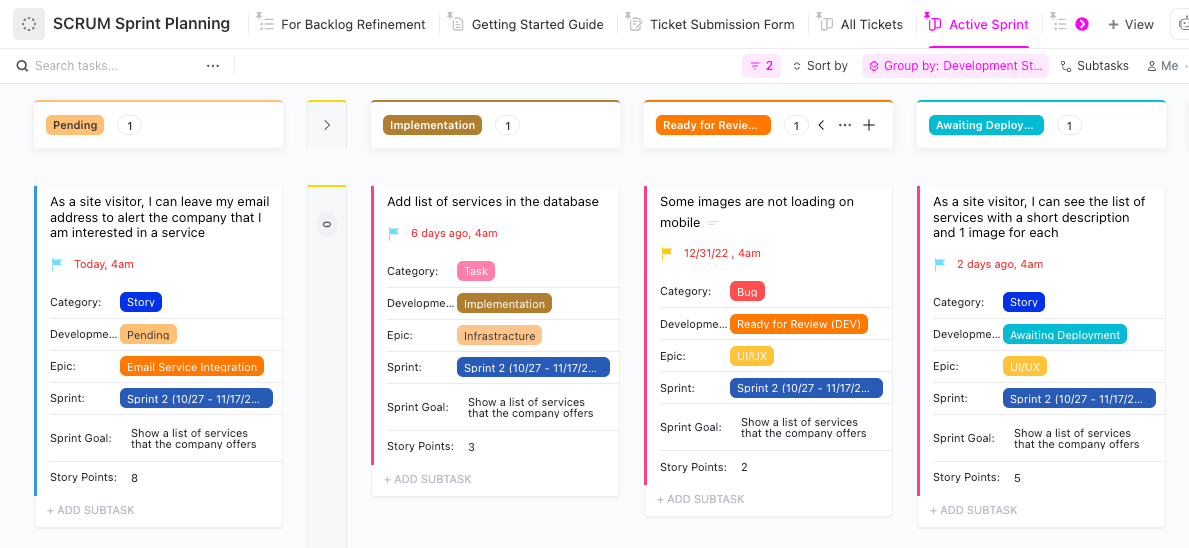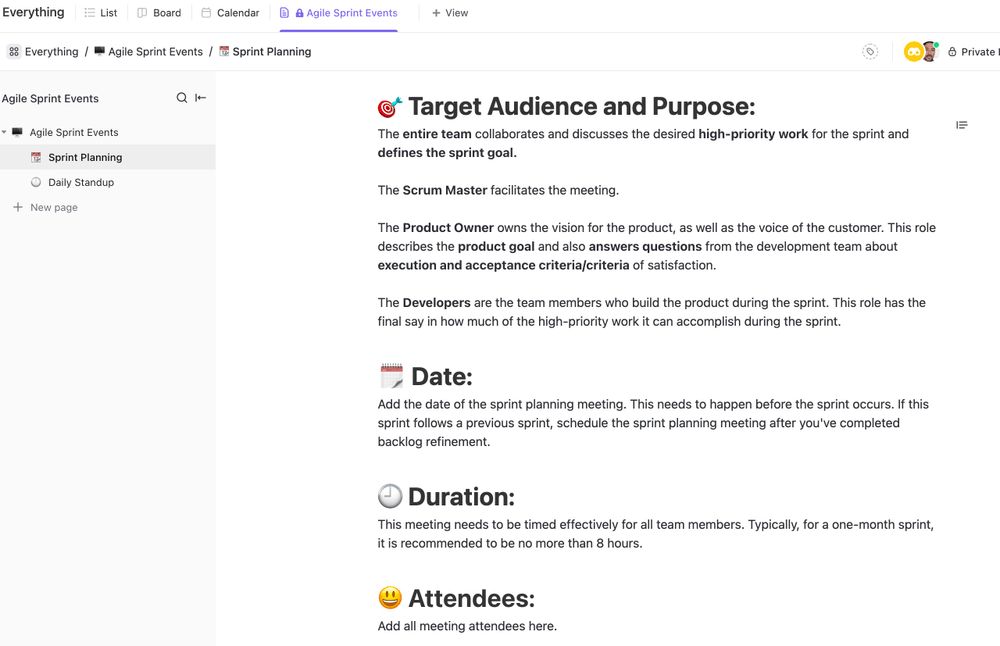مع تقدم التكنولوجيا، يتقدم معها تعقيد العديد من المشاريع. وعلى مر السنين إدارة المشاريع ظهرت أطر عمل تسمح لمديري المشاريع بمراقبة و إدارة التقدم المحرز لمشاريعهم بشكل أكبر.
و سكروم هو أحد هذه الأطر التي تكتسب شعبية في إدارة المشاريع الرشيقة . يجعل من الأسهل تقسيم المشاريع الكبيرة إلى مهام أصغر يسهل إدارتها وتتبع كيفية تقدم هذه المهام.
يمكن أن يساعد تطبيق Scrum بشكل صحيح أعضاء الفريق على البقاء على المهمة وإكمال المشاريع بشكل أسرع وبأخطاء أقل. يمكن لمديري المشاريع الاستفادة من القوالب لضمان أن يكون لديهم سير عمل سكروم يتبع إطار العمل بدقة.
في هذا المنشور، سنقدم عشرة قوالب سكروم التي تناسب مجموعة متنوعة من حالات الاستخدام وسير العمل.
ما هو قالب سكروم؟
قالب Scrum هو مستند أو أداة منسقة مسبقًا تُستخدم لمساعدة الفرق على تنظيم وتخطيط العمل ضمن إطار عمل Scrum. توفر قوالب Scrum نهجًا متسقًا ومنظمًا لإدارة المهام والتقدم، ويمكن أن تساعد الفرق على البقاء على المسار الصحيح وتحقيق أهدافها في إطار إدارة المشاريع الرشيقة.
تتضمن بعض الأمثلة على قوالب Scrum قوالب Sprint backlogs، والتي تسرد جميع المهام التي يجب إكمالها خلال سباق محدد، وقوالب Product backlogs، والتي تسرد جميع المهام التي يجب إكمالها لمشروع أو منتج معين. قد تتضمن القوالب الأخرى جداول أعمال الاجتماعات، والمخططات المتراكمة والتقارير بأثر رجعي.
تم تصميم هذه القوالب لدعم عملية Scrum، مما يضمن أن يكون لدى فريق تطوير البرمجيات لديك فهم مشترك للعمل الذي يتعين القيام به، وكيف سيتم إنجازه.
لماذا تعتبر قوالب سكروم مهمة للأعمال الرشيقة؟
تعد قوالب Scrum ضرورية للأعمال المخصصة لـ سير العمل الرشيق لأنها توفر الهيكلية والاتساق في طريقة تنظيم العمل والتخطيط له. وهذا يساعد مدير سكروم على إدارة فريق تطوير البرمجيات الرشيق بحيث يبقى الجميع على المسار الصحيح ويحققون أهدافهم بكفاءة أكبر.
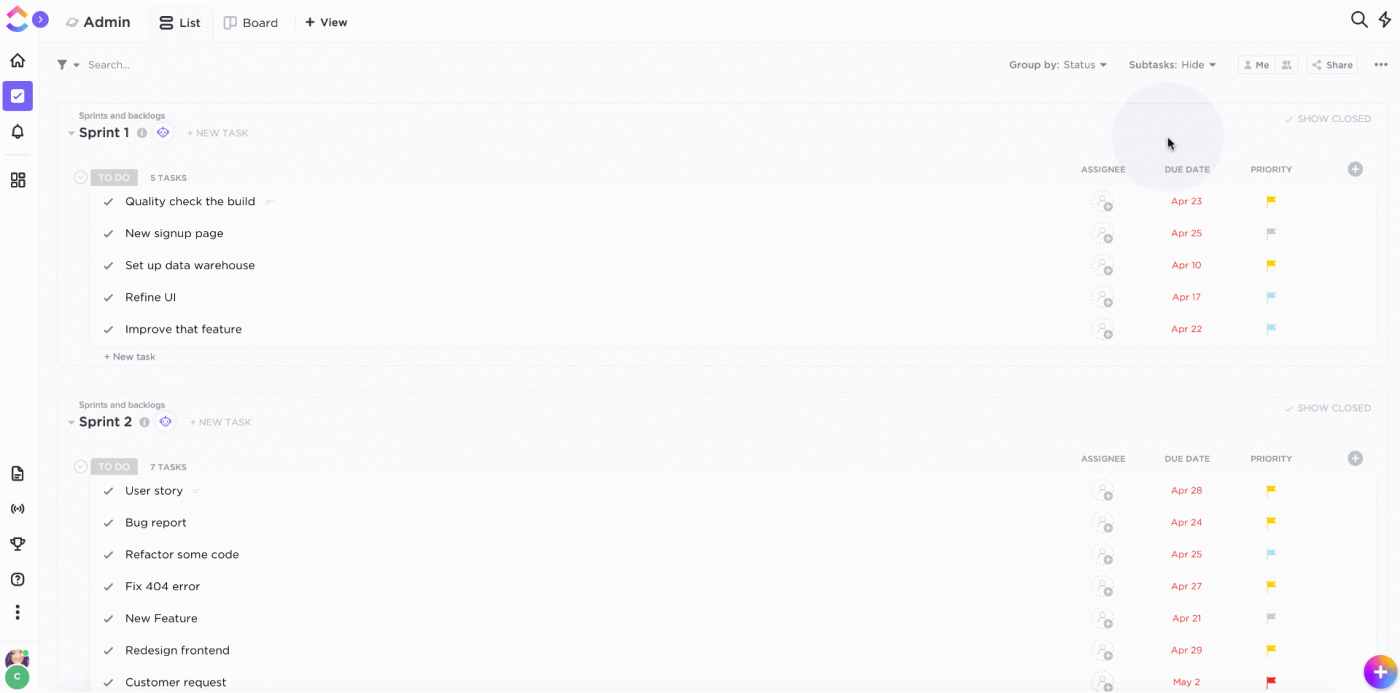
تسهّل القائمة المنسدلة لنقطة سكروم في ClickUp على الفرق تتبع ومراقبة مدى تعقيد العمل المنجز
قد يعتقد الفريق أنه يفهم عملية سكروم وقد يعرف تعريفات جميع مصطلحات أجايل سكروم عن ظهر قلب، ولكن لا يزال لا يتم توفير القدر المناسب من التركيز لتنفيذ مهمة سكروم بشكل صحيح.
نموذج سكروم يحل هذه المشكلة لفرق العمل الرشيقة:
إنه يضمن أن يكون لدى جميع الفرق المستقلة فهم مشترك للعمل الذي يجب القيام به مع تحسين الرؤية في خطة المشروع التقدم. هذا يبسط العملية لتقليل الوقت والجهد المبذول في تنظيم وتخطيط العمل. فهي تسمح للبرامج أو التسويق الرشيق الفرق للاستجابة بسرعة للتغييرات والتكيف مع التحديات الجديدة، وهو أمر بالغ الأهمية في بيئة دائمة التغير.
ما الذي يجعل قالب سكروم جيدًا؟
قالب سكروم الجيد سهل الاستخدام وواضح للفهم. غالبًا ما يتم استخدامه ضمن أدوات الفريق الرشيقة، فهو يوفر إطار عمل رشيق قوي لاتباع عملية سكروم. فيما يلي بعض العوامل التي تجعل قالب سكروم جيدًا:
- سهل الاستخدام: يجب أن يكون القالب سهل الفهم والتعبئة والتحديث. يجب أن يكون لديه تصميم بديهي يسمح للموظفين بالبدء بسرعة مع الالتزام بالمنهجية الرشيقة
- واضح: واضح: يجب أن ينقل القالب معلومات حول عملية سكرم والحالة الحالية للمشروع ضمن تلك العملية. لا يكفي فقط أن يكون سهل الفهم، بل يجب أن يسلط الضوء على سير عمل سكرم.
- يدعم عملية سكرم: يمكن أن توفر العديد من النماذج لمحة موجزة عن مفاهيم Scrum، لكن النموذج الجيد سيذهب إلى أبعد من ذلك. سيجعل من السهل تتبع من يعمل على ماذا، وما هو دوره، ومدى تقدمهم في كل مهمة من المهام الموكلة إليهم.
- قابلة للتخصيص: ليس كل مشروع متشابه. في حين أن عملية Scrum بسيطة، فإن قوتها الحقيقية تأتي في قدرتها على التكيف. على الرغم من أن بعض قوالب Scrum ستكون مصممة لمهام محددة ضمن إطار عمل Scrum أو أنواع محددة من المشاريع، إلا أن كل منها يجب أن يسمح بالتخصيص الكافي لتناسب جميع حالات الاستخدام الضرورية.
- أتمتة: يمكن أتمتة بعض القوالبتوفير الوقت وزيادة الدقة. يجب أن يكون القالب مؤتمتًا إلى الحد الذي يسمح بتحديثات سهلة ومراقبة التقدم المحرز.
- يوفر الرؤية: يجب أن يوفر قالب Scrum الجيد رؤية واضحة لتقدم المشروع، مما يسمح لأعضاء الفريق برؤية ما تم إنجازه بسهولة، وما الذي يتم العمل عليه حاليًا، وما الذي لا يزال يتعين القيام به.
- مدفوع بالبيانات: يجب أن يكون القالب قائمًا على البيانات، بمعنى أنه يجب أن يكون قادرًا على جمع البيانات وتخزينها وتحليلها. يجب أن يسمح أيضًا باستخراج البيانات والتقارير بسهولة.
- قابلة للتنفيذ: يجب أن يشتمل القالب على خطوات تالية واضحة وقابلة للتنفيذ، وأن يساعد في تركيز عمل الفريق على خطة المشروع الشاملة.
من خلال اتباع هذه الإرشادات، يمكن لقالب Scrum الجيد أن يساعد الفرق على البقاء على المسار الصحيح، والعمل بكفاءة أكبر، وتحقيق أهدافهم - كل ذلك باستخدام الأدوات الرشيقة المناسبة.
## 10 قوالب سكروم يجب مراعاتها لفريقك في عام 2024
هذه القوالب مخصصة لمراحل التخطيط والتنفيذ لسير عمل سكروم. لدينا قائمة منفصلة من القوالب التي ستساعد فريقك على تنظيم سبرنت بأثر رجعي .
1. قالب ClickUp Agile Scrum Management Template
قالب ClickUp Agile Scrum Management قالب إدارة سكروم الرشيقة
لدينا قالب إدارة سكروم الرشيقة يتضمن جميع العناصر الأساسية لسير عمل سكروم. سيساعد مديري المشاريع على تتبع الأعمال المتراكمة والنتائج المتراكمة وسباقات السرعة وإدارة الاختبارات والمراجعات. يغطي هذا القالب إدارة سكروم من مستوى واسع وهو مصمم لدعم الفرق التي تحتاج إلى تتبع المشاريع المعقدة والبقاء على المسار الصحيح مع أهداف سكروم التي تم وضعها.
يوفر القالب نهجًا واضحًا ومتسقًا لتنظيم وتخطيط العمل. بالإضافة إلى ذلك، يتضمن قالب سكروم هذا مستند "كيفية البدء". سيجد فيه مديرو المشاريع وأعضاء الفريق على حد سواء معلومات مفصلة حول كيفية استخدام القالب بفعالية.
يضمن استخدام الدليل أن تتمكن الفرق من فهم وتنفيذ الميزات والحقول المخصصة التي يوفرها القالب بسرعة، مما يسهل البدء في استخدامه على الفور في عملية إدارة المشروع الرشيقة.
2. انقر فوق قالب قائمة أخطاء Agile Scrum Agile Scrum
قالب قائمة أخطاء ClickUp Agile Scrum Agile Bugs List Template
لدينا قالب قائمة أخطاء رشيق سكروم رشيق يوفر نظرة إضافية على قالب إدارة سكروم الرشيقة الأساسي المذكور أعلاه. يجعل عرض قائمة الأخطاء من السهل تتبع الأخطاء وإدارتها عند ظهورها، باستخدام سير عمل سكروم. عند استخدام هذا القالب، ستجد واجهة واضحة ومتسقة توفر أدوات لتحديد الأخطاء وتحديد أولوياتها وحلها.
وهو يتيح لأعضاء الفريق تسجيل جميع المعلومات المهمة اللازمة لتوثيق الأخطاء وحلها، مع أقسام لوصف الخطأ، ومستوى الأولوية، والشخص المسؤول عن حلها، وحالتها الحالية. يمكن استخدام هذا النموذج جنبًا إلى جنب مع قوالب سكروم الأخرى في هذه القائمة لضمان تحديد الأخطاء ومعالجتها على الفور.
باستخدام هذا القالب، فإن فريق سكروم تحسين قدرتهم على تحديد الأخطاء وترتيب أولوياتها وفقًا لتأثيرها على المنتج النهائي أو مرحلته الحالية، وتتبع التقدم المحرز في حلها.
3. قالب مجلس إدارة ClickUp Scrum Board
قالب لوحة ClickUp Scrum Board
هذا قالب لوحة سكروم هو عرض إضافي آخر لقالب الإدارة الرشيقة. في إطار سير عمل سكروم، تعد لوحة سكروم طريقة فعالة للفرق لتصور وتنظيم عملهم - سواء كان ذلك في قصص المستخدمين أو تتبع الأخطاء.
A لوحة سكروم يوفر تمثيلًا مرئيًا للمهام التي يجب إكمالها، ويتتبع التقدم الذي تم إحرازه، ويسهل رؤية حالة كل مهمة. تنقسم طريقة العرض هذه لقالب الإدارة إلى أعمدة تسمح بإلقاء نظرة سريعة على موقع كل مهمة في العملية.
ستجد أعمدة للمهام التي يجب إنجازها، وتلك التي تم قبولها أو رفضها. هناك أيضًا أعمدة للمهام المعلقة أو التي تنتظر الموافقة عليها.
على عكس لوحات سكروم المادية، فإن اللوحات الموجودة في هذا القالب يمكن تحديثها بسهولة وأتمتتها. يمكن أن تتكامل بسهولة مع الأدوات الأخرى في مجموعتك التقنية بحيث تكون المعلومات حول تقدم مشروعك دائمًا في المكان الذي تحتاجه بالضبط.
/href/ /مدونة؟ p=65155 قوالبالقوالبالقصصية *%/href/_
!
4. انقر فوق قالب تراكم الأعمال المتراكمة Agile Scrum
قالب ClickUp Agile Scrum Backlog Template
نموذج نموذج Agile Scrum Backlog Template يقدم نظرة أخرى على قالب إدارة Agile Scrum Management ويوفر عرضًا لتراكم الأعمال المتراكمة. تعتبر الأعمال المتراكمة جزءًا مهمًا من سير عمل سكروم. يتعلق هذا العرض الخاص بـ الأعمال المتراكمة للسباق السريع بدلاً من تراكمات المنتج.
يتم استخدام الأعمال المتراكمة في العدو السريع من قبل فريق التطوير لتتبع التقدم المحرز في العدو السريع. سيقومون بملء مهام الأعمال المتراكمة (مرة أخرى، ليس بالضرورة أن تكون الأعمال المتراكمة للمنتج) أثناء مرحلة التخطيط للسباق السريع.
هذا القالب يجعل من السهل عليهم تتبع المهام التي تم إكمالها في العدو الحالي، وما هي مرحلة الإنجاز التي لم يتم إكمالها.
5. انقر فوق قالب أولوية أخطاء سكرم الرشيقة
ClickUp Agile Scrum قالب أولوية أخطاء سكرم الرشيقة
تمامًا كما يجب على المستشفى تحديد أولويات المرضى في غرفة الطوارئ بناءً على شدة إصابتهم، يجب على فرق التطوير تحديد أولويات الأخطاء بناءً على تأثيرها على المشروع. إن قالب أولوية أخطاء رشيق سكروم الرشيق يوفر لهم الأدوات اللازمة للقيام بذلك.
سيتمكن المطورون من تصنيف الأخطاء حسب خطورتها وعرضها بهذا الشكل من خلال هذا العرض لقالب إدارة سكروم الرشيق الأصلي. وهذا يعطي لمحة عن عدد أنواع الأخطاء المتبقية ويسمح لأعضاء الفريق بتحديد الأخطاء التي يجب العمل عليها أولاً بسرعة.
من خلال استخدام طريقة عرض أولوية الأخطاء بشكل صحيح، يمكن لمديري التطوير تجنب أو إدارة الأخطاء بشكل صحيح الديون التقنية وتقليل فرص حدوث تأثيرات سلبية من الأخطاء التي لم يتم تحديد أولوياتها بشكل صحيح.
6. انقر فوق قالب تخطيط سبرينت سبرينت قالب تخطيط سبرينت كليك أب
قالب تخطيط سبرينت سبرينت قالب تخطيط ClickUp Scrum Sprint
حان الوقت الآن للانتقال إلى قالب آخر وإلقاء نظرة على بعض المشاهدات التي يوفرها.
لدينا نموذج تخطيط سبرينت سبرينت سبرينت يفعل ل التخطيط للسباق السريع مرحلة ما فعله نموذج الإدارة لمرحلة التنفيذ. قبل كل سبرنت، يجب إجراء تخطيط دقيق لضمان أن المهام التي سيتم إنجازها تحرك المشروع نحو أهدافه بأكثر الطرق إنتاجية.
هذا قالب يسمح لمخططي السباق بتتبع المهام التي ستحتاج إلى إكمالها خلال السبرنت، وهدف السبرنت الحالي، وغيرها من المعلومات التي ستساعد في إعداد فرق سكرم لسباق سريع ناجح.
7. قالب سبرينت النشط لـ ClickUp Scrum Active Sprint
قالب ClickUp Scrum Active Sprint Template
قالب ClickUp نموذج سبرينت سبرينت النشط لسكروم ضمن قالب تخطيط Scrum المذكور سابقًا سيعرض لك معلومات حول سباقات السرعة النشطة حاليًا. يتم تنظيم سباقات السرعة في أعمدة توضح ما هو قيد التطوير، وجاهز للمراجعة، وفي انتظار النشر، وغير ذلك.
لكل مهمة في عمود ما، يمكن بسهولة عرض المعلومات المهمة حول فئتها وحالة التطوير والإطار الزمني والهدف منها دون أي خطوات إضافية.
8. قالب اجتماع ClickUp Scrum
قالب اجتماع ClickUp Scrum
اجتماعات سكروم هي عنصر رئيسي آخر في سير العمل. وعادة ما تعقد هذه الاجتماعات يوميًا. فهي تسمح للفريق بتقييم العمل الذي تم إنجازه وما لا يزال ينتظرنا.
وهي مهمة للطبيعة الرشيقة لـ "سكروم" لأنها المكان الذي يتم فيه حساب حواجز الطرق والعقبات الأخرى المكتشفة حديثًا وتناسب جدول السباق. لدينا قالب اجتماع سكروم سيجعل من السهل التخطيط لهذه الاجتماعات وتنفيذها.
يوفر هذا القالب طريقة سهلة لأعضاء الفريق للمساهمة في الاجتماع بتفاصيل حول ما أنجزوه منذ الاجتماع الأخير، وما هي العوائق التي يواجهونها حاليًا، وما يخططون للقيام به لهذا اليوم.
9. قالب أحداث كليك أب سبرينت
قالب أحداث كليك أب سبرينت
نموذجنا الأخير من القائمة هو قالب قالب أحداث العدو السريع الرشيق . يوفر هذا القالب موقعًا مركزيًا لتوثيق التفاصيل حول عملية العدو السريع بأكملها. ستتمكن فرق Scrum من تتبع جميع ملاحظات اجتماع الحدث والقرارات والأحداث والدروس المستفادة التي حدثت أثناء عملية العدو السريع.
هذا يجعله مستندًا مناسبًا لمشاركته مع أي من أصحاب المصلحة، أو للحصول على نظرة عامة سريعة حول كيفية سير العملية بأكملها، أو للرجوع إليه كتمرين تعليمي لسباقات السرعة المستقبلية.
10. انقر فوق نموذج إدارة سكروم الرشيق الرشيق
قالب ClickUp Agile Scrum Management قالب إدارة سكروم الرشيقة
إذا كنت جزءًا من فريق رشيق أو مدير سكروم، فإن هدفك الرئيسي هو إنتاج أفضل منتج ممكن. مع كل المشاريع المعقدة والعمليات المستهلكة للوقت التي تنطوي عليها هذه المهمة، قد يكون من الصعب البقاء على رأس كل شيء. نموذج إدارة Agile Scrum لإدارة Agile Scrum من ClickUp يوفر الراحة! هدفنا هو توفير الوقت والجهد الثمين لفريقك مع ضمان نتائج متفوقة - نموذج Agile Scrum الخاص بنا يفعل ذلك بالضبط! تأكد من وصول فريقك الرشيق إلى آفاق جديدة مع ClickUp اليوم!
تبسيط عملية سكروم الخاصة بك مع ClickUp
قوالب Scrum هي أداة قوية لتنظيم وتخطيط المشاريع التي ستستفيد من إطار عمل Scrum. من خلال القوالب التي أبرزناها في هذا الدليل، يمكن لفريقك الحصول على رؤى قيمة في سير عمل مشروعك وتهيئة أنفسهم لتحقيق إنتاجية أكبر.
ومع ذلك، من المهم أن تتذكر أن القالب هو مجرد جانب واحد من جوانب عملية سكروم. للحصول على أقصى استفادة من القالب، يجب أن تكون الأدوات التي تستخدمها لتنفيذه ذات جودة عالية أيضًا.
يوفر ClickUp منصة مركزية حيث يمكن للفرق تنظيم المهام وتتبع التقدم المحرز والتواصل مع بعضها البعض. وهو يوفر مجموعة متنوعة من عمليات التكامل وخيارات التخصيص، مما يجعله مرنًا وقابلًا للتكيف مع الاحتياجات المحددة لفريقك. جرّب ClickUp وشاهد كيف يمكن أن يساعدك في تحسين إنتاجية فريقك وتحقيق النجاح في مشاريعك.



